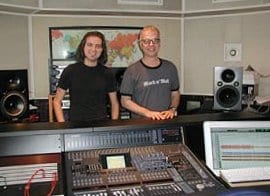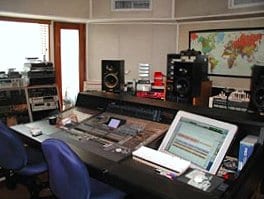Tony Visconti Gambles and Wins on Digital
BUENA PARK, CA (September 2, 2004) As the powerhouse behind the David Bowie classics The Man Who Sold the World, Diamond Dogs, Young Americans, Low, Heroes, Lodger and Scary Monsters, producer/engineer/arranger Tony Visconti has been enjoying a Bowie reunion of sorts, working on 5.1 remixes of selections from the superstar's catalog, including Stage and David Live. Those remixes not only allowed Visconti to revisit some of his early work, but also became the catalyst to update his space in Philip Glass' studio, The Looking Glass, in New York City with a Yamaha DM2000 digital mixing console and MSP10 Studio monitors, plus LOGIC 6.4.2 and Pro Tools 6.2 recording media. |
"Conventional analog desks can be a challenge with 5.1," explains Visconti. "Some of them don't have the proper routing, and you've got to do all kinds of tricks. These projects were time-sensitive, so we needed gear that was 5.1-oriented, and digital boards seemed like the only option. Admittedly, I was hesitant. Having used all-in-one DAWs and computer-based recording, I was used to multi-menus and multi-layers, but hadn't gone digital 100 percent on any one project." A visit to New York's Right Track Recording, suggested by Visconti's manager Joe D'Ambrosio, changed Visconti's view on the digital audio path. "They had a new Yamaha DM2000," says Visconti, "and when I heard it, it blew away all the myths about digital audio, like 'it's brittle,' or 'it's cold-sounding.' This was really intuitive and had a fat, warm sound, great EQs, real controllability, a graphic reading for everything and best of all, incredible sonic quality. We mixed Stage on it, and midway through David Live, I purchased my own." Visconti and his engineer, Mario McNulty, have used the DM2000 in combination with Pro Tools and LOGIC since May. "We're using it primarily to mix, rather than control," he says, "feeding in the Pro Tools and LOGIC channels and making all the moves on the console. We've also done some fixes, like flying in a guitar. The 'snap,' 'save' and 'recall' features have cut production time in half. For example, if you're in a better sonic state near the end of a mix session, you can recall in Pro Tools and on the DM2000 instantly. What's more, going from stereo to 5.1 is now like doing one mix. Fold down 5.1 doesn't work for the simple reason that most people still listen in stereo. So for these Bowie projects, the stereo mixes happen first, and all the moves are done in automation. Mario has found a way to keep moves, EQs and scenes intact and then open it up to 5.1. We've discovered a lot of things as we work that aren't in the manual." |
The MSP10 Studio monitors six in all were also something new for Visconti. "I originally wanted to test them out," he says, "but I ended up keeping them the imaging is perfect. They're a vast improvement over previous models, and the low end is just as it should be. In stereo I haven't needed to use the SW10 [subwoofer]."
Remixing live concerts has allowed Visconti to create a total live experience in 5.1. "We've been doing a lot of sound to video, and the SMPTE lockup has been great," he says. "The first project for the board [at The Looking Glass] was a Bowie DVD of his 2003 Dublin concert (scheduled for release in September)," he notes. "First, we upgraded our DM2000 software to V2. We got Quicktime versions of the show, watched and mixed the concert locked up completely Pro Tools, DM2000 and picture. With the audience and the reverb in the rear channels, and the band in the front speakers, you really get an idea of the room's size. I'll leak the bass and kick drum into all the speakers, since those elements should be powerful and non-directional. The vocal comes a little forward and lives sonically about 10 feet in front of the band basically, where you'd see the singer. The DM2000 has a great 5.1 matrix graphic, so rather than putting the vocal right in the crosshairs, I'll put them just above the middle. Wrapping the guitar around a little bit also yields a fuller sound. He continues, "Between the DM2000 and our plug-ins, we can make up custom sounds, but we are using the onboard reverbs for slapback, plus the channel EQ and compression. If you're staying in the digital world, the patchbay should stay as bare as possible. For analog work, we have an Avalon VT-737 SP, which is my favorite vocal chain. My buddy Malcolm Tuft sent me his ATC-2, which is a great stereo preamp, and is nice on drum overheads. We also have a Focusrite Red quad preamp, which is very good on snare and toms. ART tube preamps and compressors have a good rock and roll sound. For a 96 channel unit, the DM2000 looks awfully small, but I've been able to get rid of stuff, go up on eBay and clean house. The studio space has doubled in size!" Visconti notes that the idea of 5.1 is to create a spatial playground. "There's an effect in an early mix of Heroes where the lyric is 'the guns shot above our heads,'" he explains. "In stereo, the gun shots are panned from left to right, whereas in 5.1, the sound moves from front to back, so you really get the idea of bullets passing by you. Only placing the band in the front and reverbs in the back is not using your six speakers creatively, so I'm not afraid to put primary information into the rear MSP10 speakers. What's great about this setup and 5.1 is that you have the luxury of putting a rhythm guitar in the back right speaker, or having a full string section in the back. Classical and jazz recordings have more strict rules, but in the rock world, anything goes. After all, rock and roll recording is basically creating an aural illusion." For more information, contact Yamaha Corporation of America, Commercial Audio Systems Division, P.O. Box 6600, Buena Park, CA 90622; telephone 714-522-9011; e-mail infostation@yamaha.com; or visit www.yamaha.com/proaudio. |
 |
| © 2010 Yamaha Corporation of America. All rights reserved. |


